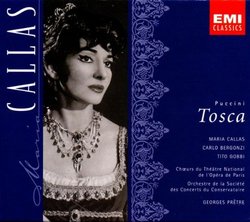| All Artists: Giacomo Puccini, Georges Prêtre, Maria Callas, Carlo Bergonzi, Renato Ercolani, Tito Gobbi, Leonardo Monreale, David Sellar, Giorgio Tadeo, Ugo Trama Title: Puccini: Tosca (complete opera) with Maria Callas, Carlo Bergonzi, Tito Gobbi, Georges Pretre Members Wishing: 1 Total Copies: 0 Label: EMI Classics Release Date: 3/17/1998 Genre: Classical Styles: Opera & Classical Vocal, Historical Periods, Modern, 20th, & 21st Century Number of Discs: 2 SwapaCD Credits: 2 Other Editions: Puccini: Tosca [Japan] UPCs: 724356644427, 724356644458 |
Search - Giacomo Puccini, Georges Prêtre, Maria Callas :: Puccini: Tosca (complete opera) with Maria Callas, Carlo Bergonzi, Tito Gobbi, Georges Pretre
 | Giacomo Puccini, Georges Prêtre, Maria Callas Puccini: Tosca (complete opera) with Maria Callas, Carlo Bergonzi, Tito Gobbi, Georges Pretre Genre: Classical
|
Larger Image |
CD Details |
CD ReviewsAN UNDERRATED GEM anonymous | san francisco, ca United States | 07/05/2001 (5 out of 5 stars) "It's common to talk about the 1953 de Sabata recording at the expense of this one. I would not do without either. This one has several advantages: 1) Though Callas's voice has deteriorated, she is in her skinny Callas voice here, not the fat Callas voice (where she sounds like she's singing into a bottle.) I like both, but if you prefer thin Callas, this is the Tosca for you; 2) This is a more histrionic TOSCA -- that doesn't make it better or worse, but it's definitely different enough to set it apart; 3) Her Vissi D'arte is her best, ever, and she recorded it many times; 4) The stereo sound is gorgeous; 5) I prefer De Stefano, but Bergonzi brings something special to this, too; 6) Gobbi, in the spirit of this production, pulls out the dramatic stops. This is the melodramatic TOSCA, and the '53 is the dramatic TOSCA. Two versions, both great." Callas is amazing! Vicki J. Kondelik | 11/17/1999 (5 out of 5 stars) "Callas' 1953 Tosca will always be my favorite, but this one is almost as good. I know that a lot of people say it's not nearly as good as the 1953 recording, but I disagree. Callas' voice was certainly in better condition in 1953, but I think her interpretation had strengthened and deepened since then. She gives an emotional, intense performance here. And she sings the greatest "Vissi d'arte" ever! I love the one on the 1953 recording, but this one is even more emotional and moving.Gobbi is probably the greatest Scarpia ever, and I think his interpretation has also strengthened since 1953. Bergonzi gives a wonderful performance as Mario. I love di Stefano in the 1953 recording, but Bergonzi is also great. This recording is definitely one of my favorites." Most Underrated Recording Ever John Atherton | CINCINNATI, OHIO United States | 08/27/2004 (5 out of 5 stars) "This 1965 Tosca has been reviled by virtually every critic, including the most fervent admirers of Maria Callas. They'll steer you to the classic 1953 recording. I have both, but find myself more often turning to this one.
Callas in 1953 had a healthier and more secure voice, but if she was shrill a dozen years later, her middle register and soft notes were, to my ears, lovelier and more touching. De Sabata's feverish conducting on the mono set is a memento of a genius who made too few recordings, but Pretre gives more breadth to this opera's stately Roman lines. By the same token, Bergonzi -- that prince among tenors -- is more elegant than Di Stefano, whose robust voice matches De Sabata's conception and Maria's earlier vocal (and physical) heft. The critics say Gobbi was sub-par in '65, but for me he is still... Gobbi. In sum, buy both if you can -- and if you like early Callas and Di Stefano, note that they were even more thrilling in Mexico City in 1952 -- but don't be surprised if you find yourself loving this neglected gem." |

 Track Listings (10) - Disc #1
Track Listings (10) - Disc #1